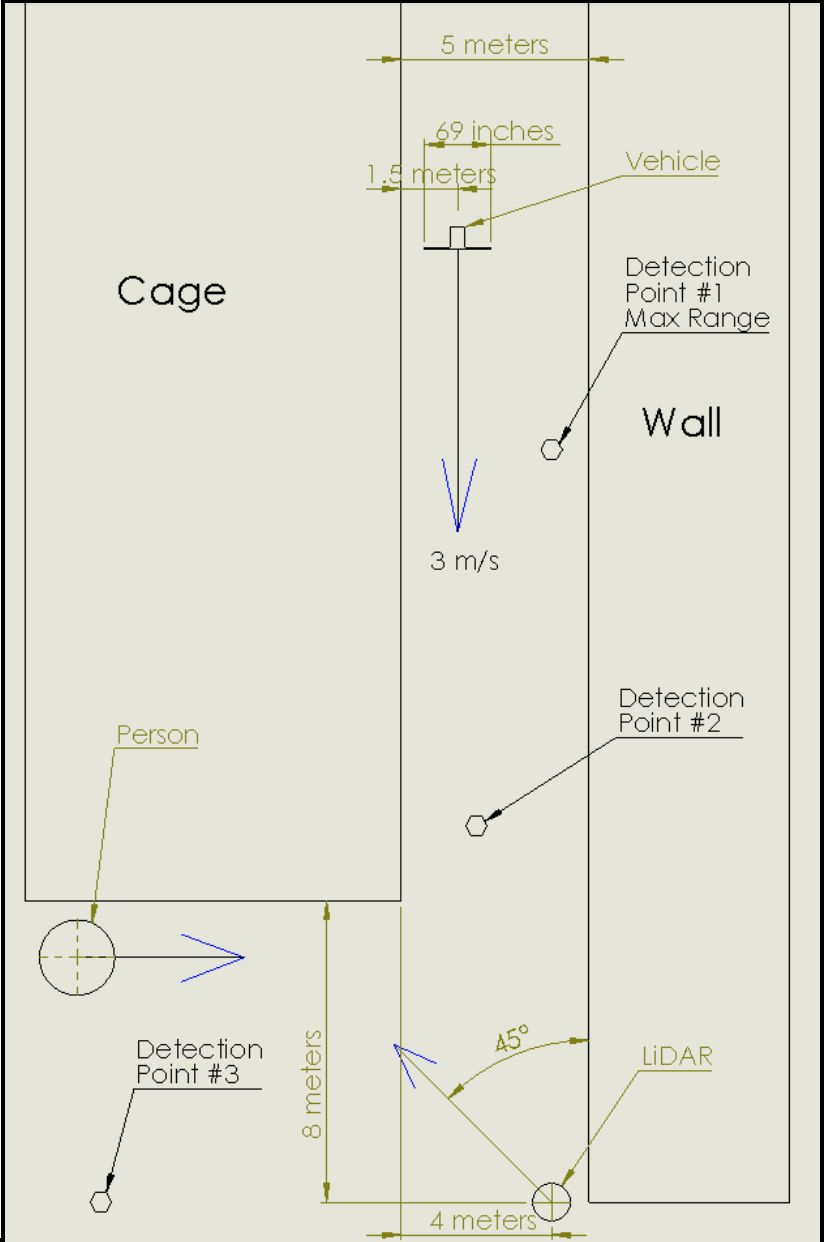Fall Validation Experiment
Oliver Krengel, Rohit Murthy, Chien Chi Ho, Pengsheng Guo, Vivek G R
Location: NSH B-Level, “east” points outward from elevator hallway, this is the +x axis
Equipment: Sensor Infrastructure, Origin Chronos Desktop PC, Team Lo-Co vehicle, human agent wearing non-black clothing
| Step | Description | Requirement |
| 0.1 | Place sensor infrastructure 8 meters south and 4 meters east of SE corner of cage. Set height to minimum, angle at 0 degrees to horizontal, 45 degrees north of west. This point is defined as the origin. | none |
| 1.1 | Measure points (-6,6), (-12,0), (-2,10), (-6,-10), (-10,10), and (0,20) from origin. Mark these points on the floor with blue tape. | Detection error |
| 1.2.1 | Human agent stands at floor marker #1. Display centroid on desktop – measure error as distance from point (8.5,0). | Detection error |
| 1.2.2-1.2.5 | Repeat step [1.2.1] for points #2-#5, respectively. Error will be measured from points (8.5,8.5), (8.5,-5.7), (-2.8,11.3), (0,14.1) in the infrastructure frame. | Detection error |
| Test 1 | Measure error from ground truth at each point.
|
Detection error |
| 2.1 | Human agent stands at floor marker #6 then walks between (0,20) and (-4,20) repeatedly 5 times. | Tracking range |
| Test 2 | Display recorded pedestrian trajectory on desktop.
|
Tracking range |
| 3.1 | Human agent walks continuously in test area. Capture fifty trajectory predictions and measured against detection 2 seconds in the future. | Trajectory prediction |
| Test 3 | Measure estimated position 2 seconds in the future against detected position.
|
Trajectory prediction |
| 4.1 | Human agent walks out of range to the north, behind wall to restroom if necessary. | Cycle time |
| 4.2 | Human agent walks back into range toward the infrastructure. | Cycle time |
| Test 4 | Display tracking information on desktop.
|
Cycle time |
| 5.1 | Set vehicle center 1.5 meters east of east cage wall, 18 meters north of infrastructure. Human agent stands 10 meters west of infrastructure, 1 meter south of south cage wall. | Stop short |
| Test 5 | Refer to diagram below for clarity on positioning.
Set vehicle waypoint to (-2.5, 0). Start vehicle. Vehicle runs at 3 m/s. Reset vehicle. Set vehicle waypoint to (-2.5,0). Start vehicle. Human agent starts walking east 2 seconds after vehicle start at a speed of ~1.5 m/s.
|
Stop short |

Spring Validation Experiment
Oliver Krengel, Rohit Murthy, Chien Chi Ho, Pengsheng Guo, Vivek G R
| Requirement | Test |
|---|---|
| Detect Multiple Pedestrians’ Centroid | Display 4 pedestrians centroids @ measured floor points |
| Track Multiple Pedestrians within 20m | Display 4 pedestrian centroid @ location 20m away |
| Predict Multiple Trajectories 2 seconds into future | Display 4 pedestrian trajectories information while in infrastructure field of view |
| Cycle time < 0.5 seconds | Timestamp first centroid, timestamp time of publish, display difference as cycle time |
| Plan around multiple pedestrians | Test course 1 time without pedestrians Test 5 times with different multiple pedestrian trajectories |